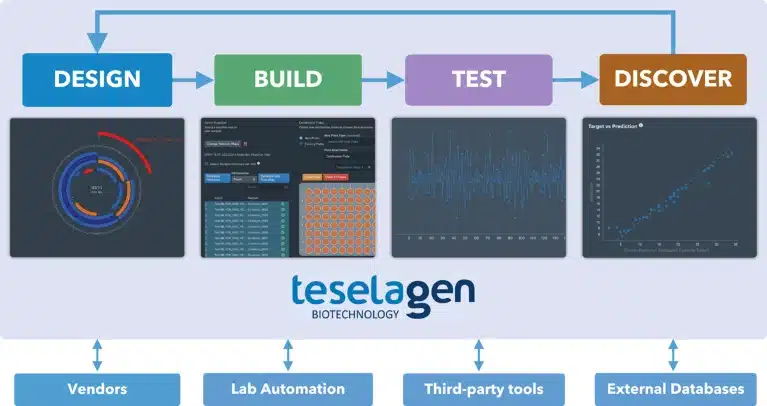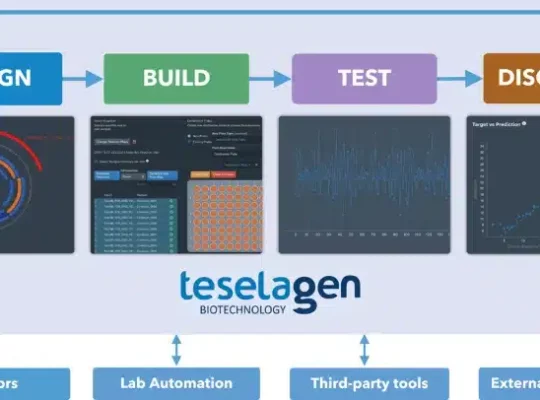TeselaGen’s artificial intelligence-enabled operating system for designing, building, and optimizing bio-based products is driving innovation across the biotechnology sector.
Biotechnology has enormous potential to solve some of the world’s most pressing challenges in health, food security, and the environment. Yet conventional methods for developing biotechnology products rely on trial-and-error based processes, which are slow and laborious. Through biological design automation, innovative and successful products can be developed at unprecedented speed.
TeselaGen is an enterprise software company based in the San Francisco Bay area that helps biotechnology companies speed-up the design–build–test–learn engineering cycle. TeselaGen has developed a cloud-based platform that guides the design of high-value bio-products by searching large solution spaces, tracking the execution of high-throughput workflows, and structuring the resulting data in a way that is amenable to machine learning (ML) algorithms.
Eduardo Abeliuk, CEO of TeselaGen, is one of the company’s co-founders. Before founding TeselaGen, Mike Fero, Nathan Hillson, and Abeliuk were working at Stanford University, spending a lot of time on tasks that they thought could be automated. “We saw an opportunity to use our engineering and technical backgrounds to help biologists speed up the process of designing, building, and optimizing experiments,” Abeliuk explained.
TeselaGen’s platform has four modules that cover each phase of the research and development (R&D) process: design, build, test, and learn (Fig. 1). It connects biologists, lab technicians and bioinformaticians so that they can work collaboratively, organize and standardize data, test, and continually learn. Biotech companies can license TeselaGen’s platform and efficiently manage complete workflows from end-to-end.

Interoperability is at the core of TeselaGen’s platform as it programmatically communicates with third-party services and software, external databases, and lab-automation equipment to capture all relevant data and speed-up R&D.
TeselaGen is working with industrial biotech, agtech, foodtech, and pharmaceutical companies developing new cell- and gene-therapy products. “The end goal is to radically accelerate the time it takes to develop a new biological product,” Abeliuk said.
Optimizing user experience
George McArthur, Senior Director of Experience at TeselaGen, said “Many companies are still running workflows in a very ad hoc fashion and get very excited about incorporating artificial intelligence (AI) and ML into their design process. However, many invest heavily in automation to generate a lot of data without realizing the software infrastructure that is required to support the generation and optimal use of that data”. On the other hand, long-time customer LanzaTech uses TeselaGen’s platform to screen thousands of designs each month. Michael Köpke, VP Synthetic Biology at LanzaTech, said “TeselaGen’s platform allows us to generate and optimize complex hierarchical libraries that would be impossible to do manually.”
TeselaGen’s platform can be set up to use customer-generated data or can embed existing relevant data from public databases to jumpstart the design of complex combinatorial molecule libraries. Moreover, as McArthur explained, TeselaGen can use AI to optimize products at the sequence level (bases in DNA or amino acids in proteins) or at the metabolic pathway level, by analyzing functionally relevant genetic elements, such as promoters, to recommend new designs.
In a paper published in Nature Communications, the Technical University of Denmark, in collaboration with TeselaGen and others, demonstrated how mechanistic and ML models can be used to optimize tryptophan production in yeast. Structured data and proprietary AI/ML algorithms were used to increase tryptophan titers and productivity by up to 74% and 43% within one iteration, respectively1.
Growing the user base
TeselaGen is helping academic groups and companies, small and large, by offering different types of feature sets. “Start-ups find it extremely useful as it helps them be systematic and learn what they need to do to scale up early on,” McArthur said.
TeselaGen’s team will set up the platform according to the customer’s system variables, available data, and the specific problem they are trying to solve. “Clients come back to tell us they wouldn’t be able to carry out the work they are doing without the software,” McArthur said. “One company reported that their productivity had shot up over 10-fold as they were able to screen 1,500 new enzymes within two weeks of setting up the system with a new robot.”
Since it was founded, TeselaGen has received four US National Science Foundation funding awards, a US Department of Energy funding award, Chilean Economic Development Agency (CORFO) awards, a Bio-IT World best practices award and multiple patent awards. A broad range of companies across the biotech sector over five continents are now using the software.
“Now that we have validated our technology and demonstrated the value it adds to biotech companies, we are eager to find new partners that can benefit from it,” Abeliuk concluded.
References
- Zhang, J. et al. Nat. Commun. 11, 4880 (2020).
